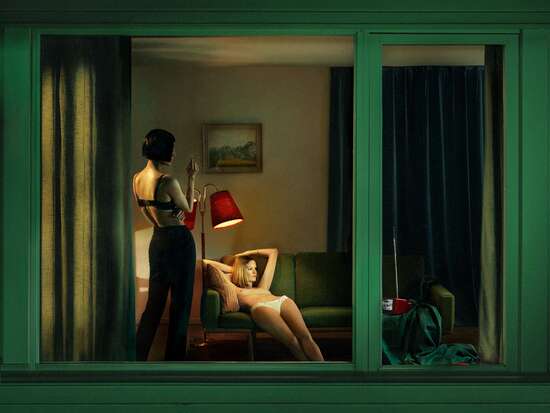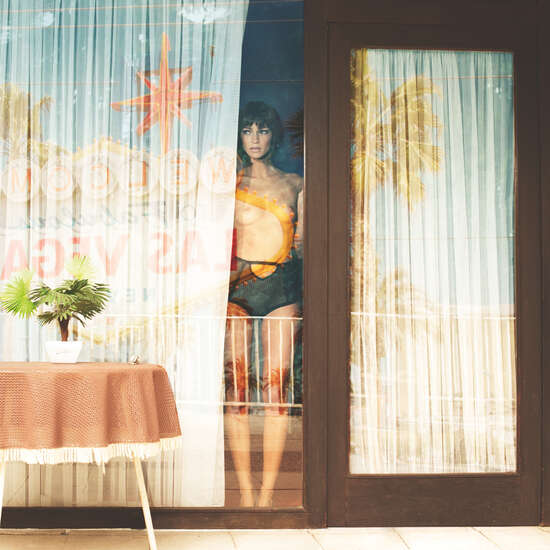READY TO HANG
Out of the box, all LUMAS artworks are ready and easy to hang.
SECURELY PACKAGED
LUMAS works are always packed to the highest standard to make sure it arrives as perfectly as it leaves us.
ARTIST SUPPORTED
Your purchase supports the free and independent work of your favorite artist.
14 DAY RETURNS
Easy 14 day returns to make sure you are satisfied with every purchase.
BACKGROUND INFORMATION
Andreas Kock is an iconoclast in the mould of Helmut Newton. The Swedish fashion photographer, known for his extraordinary fashion shoots, looks to the ideas and images of art and film history for his inspiration. His new photo series is called “Little Miss Newton.” It is hard to picture a more fitting tribute to the founder of the fashion-nude genre.
Stephan Reisner
REAR WINDOW
Do you remember Hitchcock’s film “Rear Window” where through the window on the other side of the courtyard a mysterious story unfolds? Something of this expectant tension – even without the violence implied in the film – can also be found in the photography of Andreas Kock from Stockholm. Originally created as a fashion spread (fashion photography is again revealed as a source of inspiring photographs...) the images fascinate through their emotionality and the mise-en-scènes so precisely arranged to the last detail. Kock is a perfectionist; his stage sets continuously develop within a conceptual phase. On the set he behaves like a theater director and wants to transfer exactly the picture he sees in his head into his Hasselblad or Mamiya. His subjects are female, self-confident, and strong – often shown in provocative poses. His clear, theatrical control of colors and light/dark contrast are reminiscent of the American painter Edward Hopper. Thus he is bound to the desire for the subtextual, the stories that he only suggests with his photographs.VITA
Andreas Kock is a man of full impact. With a background as an art director, his interest for photography, conceptual visuals, fashion and, not least, women soon took overhand. As a photographer, he instantly developed his own trademark idiom, based on qualities such as high energy, rich color and intense interaction with his models, with the rare capacity of creating images with ”stopping power” and sometimes an element of provocation. Andreas stages both his individual images and his fashion stories very carefully, meticulous in every detail, always based on a strong conceptual idea, often inspired by art, cinematography, sex and by women in themselves. Chinese film, and director Wong Kar-Wai in particular, are among his most important references. Of photographer colleagues, Andreas is an admirer of classic master Richard Avedon and of Philip-Lorca diCorcia, the great trendsetter of the late nineties. As his style of direction is highly personal, Andreas prefers to work with the same models over longer periods of time. Recently, Andreas Kock has worked extensively with high profile editorials for magazines such as Bon, Plaza, Glamour and Tush, and commercially for brands the likes of JC, Don Donna and Saab.INTERVIEW
The 'stalker series' was first at LUMAS over 10 years ago and was an instant success. The new artworks are a continuation of the series exclusive for LUMAS. Can you share what inspired you in creating these new artworks?
"I've been curious for a while about creating images featuring Wes Anderson-inspired characters and sets, but with a more Edward Hopper-esque aesthetic. So, I basically combined Wes Anderson-inspired characters, styling, and props, and placed them within an Edward Hopper painting."
What is the overarching theme or message that you aim to convey through this new series?
"As always, the stalker theme serves as the root and primary source of inspiration, creating tension within the work. I aimed to make this series feel more analogue and akin to paintings. In an era where AI generates hyper-realistic photos, it's more crucial than ever to highlight genuine handcrafted work and carefully oversee its production.
To achieve this, I shot these images using high-speed 120mm film and pushed it one full stop to enhance the grain in the negatives."
Your meticulous attention to detail and precision in staging is evident in your work. Can you tell us more about how you approach the conceptual phase and how it evolves on set? How do you ensure that the final image aligns with the vision you initially had?
"I'm very cautious and precise in planning the work, including set design, characters, models, styling, colors, lighting, and more. Each image is carefully crafted for aesthetics. However, once I start shooting, anything can happen within the framework I've initially created. I find myself quite free in the process once I'm behind the camera; the rigidity is in the initial planning stage."
The concept of 'Rear Window' brings a sense of expectant tension to your photography, reminiscent of Hitchcock's film. How did you go about translating this atmosphere into your images, and what was the creative process like behind this particular set?
"This set drew inspiration from a blend of the colors found in Edward Hopper's paintings and the style seen in Wes Anderson's movies. Additionally, there's a subtle homage to the legendary Swedish filmmaker, Ingmar Bergman."
Could you share further influences that have played a significant role in your work, and how you've integrated those inspirations into your photography?
"I like to think that my work is highly personal, but it's inevitable that my sources of inspiration and artistic role models will be evident in my creations. Artists such as the painter Edward Hopper and photographer Philip-Lorca Di Corcia have had a profound impact on me over the years. I always return to these sources."
Your subjects often exude self-confidence and strength, portrayed in provocative poses. What draws you to capturing these qualities in your photography, and how do you work with your models to bring out these characteristics?
"I don't sneak around and try to bring out something from the models that isn't there. I consciously select models who are confident and understand what I expect from them during the shoot. For example, if I want someone to be nude on the set, it's not a big deal; it's anticipated and the most natural thing. I believe that this confidence is evident in the models featured in my photographs."
Can you share any insights into the challenges or unique experiences you encountered while working on 'stalker'? were there any moments that particularly stood out to you during the creation of this series?
"When shooting through windows, it's preferable to do so at night to minimize reflections. The general rule is that the interior should be brighter than the outside. Due to a delay in the production, I had to capture the series during the brightest time of the year in June in Stockholm, Sweden (which was, obviously, a mistake). This limited me to a maximum of 4 hours of shooting, as the sun set at 11 pm and rose at 3 am. It was, to say the least, an extremely stressful experience. I had initially planned for 6-8 shots, but I barely managed to capture 5."
Beyond the visual aesthetics, your images often evoke a sense of narrative or storytelling. Are there specific stories or themes that you find yourself returning to in your art?
"I tend to include elements in the pictures—clues that might trigger the viewer to create their own individual story. I prefer to suggest stories rather than explicitly tell them."
How do you envision the impact of your art on those who experience it? What emotions or thoughts would you like viewers to take away from your work?
"I aim for my art to evoke strong reactions. I hope viewers feel aroused, curious, visually captivated, and struck by its beauty."
Looking ahead, can you give us a glimpse into your artistic plans for 2024? Are there any exciting projects or themes you're particularly eager to explore in the coming year?
"As for my artistic plans in 2024, I'm currently working on a significant exhibition. While I can't reveal the specific content at this time, I can say that it involves a unique exploration of fashion aesthetics turned upside down. Additionally, I'm actively engaged in creating large-scale acrylic canvases."











 No thanks, I would like to stay on this site.
No thanks, I would like to stay on this site. Yes, I would like to switch.
Yes, I would like to switch.